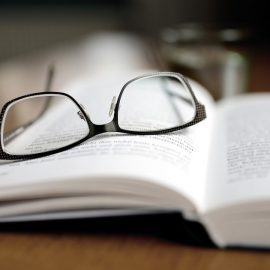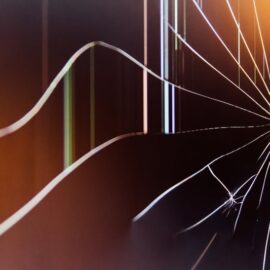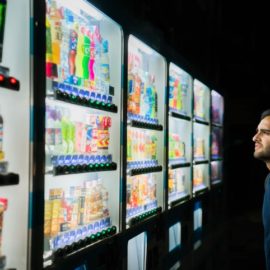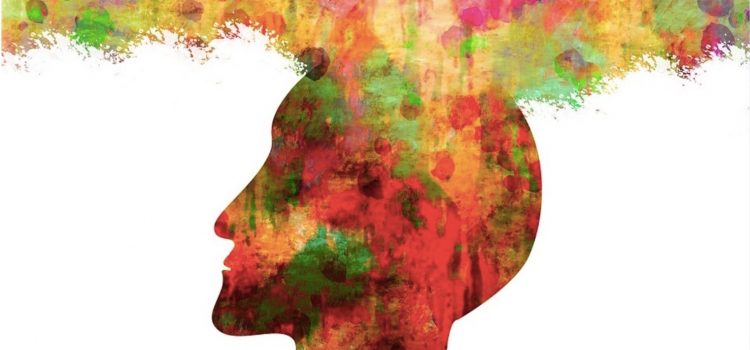
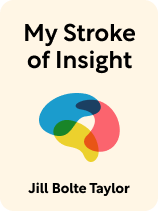
This article is an excerpt from the Shortform book guide to "My Stroke of Insight" by Jill Bolte Taylor. Shortform has the world's best summaries and analyses of books you should be reading.
Like this article? Sign up for a free trial here.
What’s it like to experience a stroke? What are some of the ways to recover with strength? Can you actually end up a “better” person as a result?
Neuroanatomist Jill Bolte Taylor suffered a stroke in 1996. In her book, she gives an account of her stroke and her recovery, and she shares the insights on mental and emotional self-care that the stroke gave her. She also provides recommendations on how best to support stroke survivors.
Keep reading for an overview of My Stroke of Insight by Jill Bolte Taylor.
Overview of My Stroke of Insight by Jill Bolte Taylor
Doctors have made great strides in understanding both the functions and the illnesses of the brain, but one neuroscientist knows them better than most. On December 10, 1996, Jill Bolte Taylor suffered a stroke on the left side of her brain, and as a scientist who specialized in the study of the brain, she was uniquely qualified to observe and report the subjective experience of losing one cognitive function after another as the damage of the stroke spread through her left hemisphere.
However, despite its disabling effects, Taylor’s stroke triggered feelings of deep inner peace and a sense of connection to the world around her. With her faculties for linear logic and judgment silenced by her left brain’s trauma, her right brain’s capacity for empathy and stillness redefined her awareness of herself and the world.
In My Stroke of Insight by Jill Bolte Taylor, you’ll see how we all have the mental wiring to find inner peace and connection with others and that, if we become aware of how our brains function, we can consciously tap its resources and reprogram ourselves to live happier, more fulfilling lives.
Jill Bolte Taylor is a neuroanatomist who (before her stroke) did research at Massachusetts’s McLean Hospital to understand the brains of people with schizophrenia. She also worked as a mental health advocate on the board of the National Alliance on Mental Illness. She’s now a public voice for educational awareness relating to the human brain and serves as the national spokesperson for the Harvard Brain Tissue Research Center.
In this guide, we’ll begin with Taylor’s explanation of the brain’s structure and how it’s affected by stroke. We’ll then summarize the events of Taylor’s stroke and how she began the process of recovery. We’ll look at the lessons that Taylor drew from her experience that have shaped her new outlook on mental and emotional self-care, as well as highlight Taylor’s recommendations for how you can provide support and encouragement for anyone in your life who’s suffered a stroke.
The Science of the Brain
To understand what happens during a stroke, it’s necessary to understand how the brain works when it’s healthy.
The Brain’s Structure
The brain is an intricate parallel processor (a system that can manage many functions simultaneously) composed of billions of nerve cells that are grouped into distinct regions. Brain function depends not only on those regions but on how the nerve cells network and communicate with each other.
Taylor identifies the limbic system, also known as the “animal brain,” as the source of your initial emotional reactions to anything you perceive in your surroundings. Surrounding the old brain is the cerebral cortex, which in humans is twice the size of that of any other species. The outermost layers of the cerebral cortex house your abilities for language, logic, and abstract thinking.
All parts of the brain are made up of information-transmitting cells, called neurons, which differ from other cells in your body in that they stop growing and replicating when you’re born. As you age, those connections become more complex. They allow for better processing of the neural inputs from your senses, they let your cerebral cortex override your emotional limbic system, and they create new cognitive pathways for data that become ingrained as you absorb new information and practice new skills.
The cerebral cortex in which all this occurs has two distinct halves connected by a bundle of nerves called the corpus callosum. The two halves of the brain work in unison but each with its own abilities, perception, and personality. When functioning normally, the two halves of the brain are an inseparable whole, and every cognitive activity—such as reading, talking, painting, or driving—takes place in both hemispheres, with each side contributing to the thought process in a different way.
The Two Hemispheres
The right brain is the home of intuition and empathy, while the left brain is the seat of logic and judgment.
As information flows in from your senses, the right brain collates all that data into a full sensory picture of your surroundings in the present moment. Your right brain also perceives things as they relate to each other, with little or no conception of boundaries. The right brain doesn’t impose value judgments and is therefore open to new information and possibilities. It’s the source of your feelings of empathy.
The left brain is your cataloger and storyteller. It takes the flow of impressions from the right brain and classifies it all via language and numbers. Unlike the right, your left brain understands time. It sorts your memories into chronological order and is able to plan ahead for the future.
Despite their different jobs, your two halves work together. And, from that cohesion, your consciousness emerges. The left brain needs inputs from the right to create its comprehensible view of the world, while the right brain needs the left’s logic and structure in order to focus amidst a sea of distractions. In terms of communication, the left brain provides your vocabulary and syntax, while the right brain adds interpretation and intuitive understanding of nonverbal cues.
Facts About Stroke
Any trauma suffered by one part will have a devastating effect on the whole. A stroke is a particular kind of brain injury that results from a malfunction of the circulatory system providing the brain with oxygen and blood. Taylor describes three different types of strokes.
- The most common strokes are ischemic, in which a blood clot blocks the brain’s circulation, causing cells to starve from lack of oxygen.
- A smaller fraction of strokes is hemorrhagic, in which a blood vessel bursts, as with an aneurysm, flooding the brain and drowning its cells.
- A very rare form of hemorrhagic stroke results from a congenital defect in the brain’s blood vessels called an arteriovenous malformation (AVM). Though AVMs account for less than half a percent of all strokes, they are the most common reason for strokes among young people, and it was precisely this type that Taylor experienced at the age of 37.
Because every brain is wired differently, the effects of strokes vary from person to person. Nevertheless, there are warning signs including the sudden onset of speech difficulties, problems with vision and balance, memory issues, numbness, tingling, or a sharp, severe headache.
If you believe you’re having a stroke, call emergency services or seek help from someone nearby. (Shortform note: It’s possible to feel some symptoms of stroke that fade after minutes or hours. Don’t ignore them.)
The Author’s Stroke and Recovery
On the morning of December 10, 1996, between the time she woke up and when she would have left for work, an undiagnosed AVM ruptured and bled into Taylor’s brain’s left hemisphere.
During the Stroke
The first symptom she felt was a stabbing pain behind her left eye, followed by an increasing sense of disconnection from her body. As she moved around her apartment, she felt that she was unusually conscious of having to direct the muscles in her legs. Normal levels of light and sound seemed unnaturally bright and loud. It was only when her right arm ceased to function that she realized she was having a stroke.
Unfortunately, she couldn’t use the phone to call for an ambulance because she’d lost the ability to comprehend numbers. Concentration grew painful, but her right brain offered feelings of peace and blissful tranquility. During her lucid moments, which grew further apart, she devised a plan to call a colleague at work. Because she’d dialed his extension many times, some of that memory was stored in her right brain.
Because her right brain could still think in pictures, she had to go through the painstaking process of matching the shape of the numbers she’d written to the shape of the numbers on the phone. She was unable to speak when her colleague answered, but he was able to deduce she was in trouble and arranged for an ambulance to come to her rescue. Once she was on her way to the hospital for treatment, Taylor says that she lost any sense of her body, and her mind completely shut down.
After the Stroke
On the afternoon of the day of her stroke, Taylor woke to an entirely different sense of awareness than she’d ever felt before. Though her left brain was dying and in shock, her right brain was fully aware and cognizant. Taylor recounts the experience of being in the world from a purely right-brain perspective.
Her senses seemed extremely sharp so that every sound, light, and touch was nearly too much to bear. Beyond that, she realized that she no longer had any sense of her body’s physical boundaries. Instead, she felt like a liquid part of a universal continuum.
Taylor also remembers feeling a great sense of peace between moments of painful intrusions from the world. Her left brain had shut down, but her right brain was fully active and conscious. Because the right hemisphere doesn’t perceive time, she experienced her existence fully “in the moment,” with no memory of the past.
With very little access to language, when someone spoke she had to absorb each word as an individual unit and puzzle them together. Without her left brain’s ability to catalog and order her sensations, she had to focus on each individual sense. Interacting with the world was a painful distraction from the deep, inner calm that her right brain continued to offer as an alternative.
Recovery Begins
Taylor understood how important it was to keep her mind active in order to have any chance of regaining her cognitive abilities. During the immediate post-stroke recovery period, she focused on maintaining her energy, challenging her language skills, and strengthening her body and mind. She discovered that sleep was the most important factor in restoring her energy levels.
The act of thinking was a great drain on Taylor’s energy, but she knew that keeping her brain active was also vital to the recovery process. She worked to regain control of her body and her ability to speak. She broke every physical or mental action down into its smallest possible steps. She uses the example of getting out of bed, for which she first had to master the skill of rocking back and forth. For mental tasks, her caregivers focused on multiple-choice questions, rather than simple yes-or-no answers, as a means to reactivate her dormant mental connections.
Only some of Taylor’s brain cells had died, but many more were still in a state of shock. She underwent surgery that was needed to repair her AVM and remove the mass of blood from her left hemisphere. Two weeks after her stroke, Taylor’s surgery was a success. When she woke afterward, she felt emotionally lifted, and she retained the power of speech she’d worked so hard to regain.
It took eight years of dedicated work—rebuilding memories, vocabulary, motor functions, and scientific knowledge—for Taylor to reach the point where she considered herself to be fully recovered. Taylor is careful to point out that how she defines “recovery” is subjective. She hasn’t regained every skill, memory, or emotional response, and some of that has been deliberate. As she relearned who she was and how to live, the stroke gave her the opportunity to choose who this new version of herself would be and to leave behind parts of her previous life that she didn’t want anymore.
Lessons Learned
Taylor says she decided to view her stroke and recovery as a gift. Her experience taught her valuable lessons about the inner workings of the mind. Let’s take a look at those lessons.
Take Charge of Your Thoughts and Emotions
Taylor argues that she’s living proof of the plasticity of the human mind—that who you were in the past doesn’t strictly define who you can be in the future. If you’re aware of how your different hemispheres influence your mental state, you can make the deliberate choice to control your thoughts and emotional processes.
Taylor felt when the left brain’s emotional patterns began to resurface, and she questioned whether she wanted to bring all of her old personality back. After all, it became clear to her that her right hemisphere was the source of many of her positive emotions, such as happiness and empathy, while her left side had housed her anger and judgmental tendencies.
When she recognized judgmental or anxious thought patterns forming, she made the conscious choice to redirect her mind and frame her thoughts in a more calming light, which helped to create new neural pathways to replace the ones that existed before.
The Root of Negativity
Taylor explains that strong emotions arise in the “animal brain” of your limbic system. However, any emotions you continue to feel after about 90 seconds are entirely in the realm of your higher brain functions. Taylor was rebuilding her reactions from scratch, she realized that, if you’re aware of this process, you can choose to short-circuit it and elect a more balanced response.
Taylor’s inner voice slowly returned as she exercised her language skills, and she learned that she could talk to herself about the way she felt. Instead of letting your own inner voice spin stories that reinforce resentment and anger, Taylor suggests that you can use your self-talk to draw a line between which emotions are helpful and which are destructive.
That’s not to say that you should never feel emotions like anger, sadness, or regret, but only that you should do so consciously so that those emotions don’t control your life. Taylor says it’s particularly useful to give yourself a 90-second break whenever you feel a strong emotional reaction.
Find Peace Inside You
Taylor says the most important lesson her stroke taught her was that a deep sense of peace and connection with the world is hardwired into the human brain. When Taylor’s stroke silenced the left side of her brain, she felt a deep, abiding sense of calm that was separate from her ego or the confines of her physical form. With only her right-brain processing to guide her, she saw and felt herself and the world as a flow of energy, not as simple matter. Because she’d lost her perception of time, Taylor concludes that peaceful awareness lies in the right hemisphere’s perception of the present moment.
Taylor insists that she didn’t develop feelings of inner peace because of her stroke—they’d been there all along, inside her right brain. But, she’d been distracted by the nonstop verbal chatter of her left hemisphere. You can achieve that sense of peace if you can learn to quiet your thoughts. The process entails slowing your mind, listening to your thoughts, learning which ones trigger negative cycles, and encouraging those that foster calmness, empathy, and joy.
What Stroke Survivors Need
People should be mindful of stroke patients’ energy levels, their need for positive reassurance, and the importance that caregivers maintain their belief that stroke patients will recover while celebrating every step along the way.
It’s important that doctors and caregivers be careful about the demands they make on stroke survivors’ time and energy. Rest is crucial both to healing and recharging, and it has to be taken as the body demands, not forced to conform to family members’ needs or the schedule of doctors making rounds.
Doctors and family members should also be aware that, while a stroke survivor may be nonverbal, they might still be fully conscious and sensitive to their emotional environment. What stroke patients need most is to be treated with gentleness, compassion, patience, and respect.
Arbitrary recovery benchmarks and schedules should be ignored, and every step forward should be celebrated in order to give the stroke survivor the encouragement needed to keep going.
It’s important to remember that the person who recovers after a stroke will not be the same person they were before. Friends and family need to cherish the person they become rather than dwell on the person who was lost. In addition, Taylor says that what’s most encouraging of all is to always treat the person you love as if you’re certain they’re going to recover.

———End of Preview———
Like what you just read? Read the rest of the world's best book summary and analysis of Jill Bolte Taylor's "My Stroke of Insight" at Shortform.
Here's what you'll find in our full My Stroke of Insight summary:
- A neuroscientist's experience and observations after suffering from a stroke
- How the author's stroke helped her develop empathy and stillness
- How best to support stroke survivors

